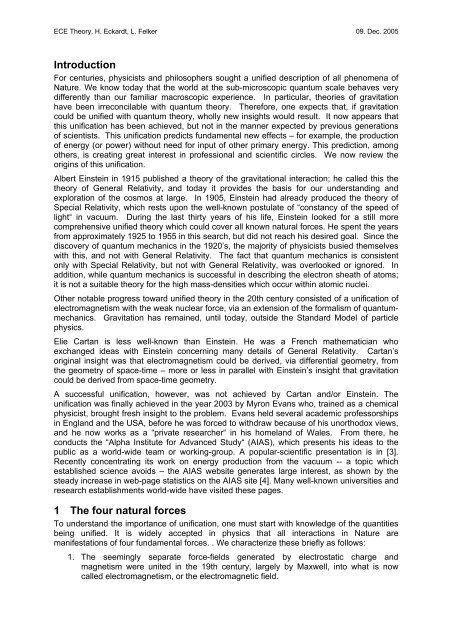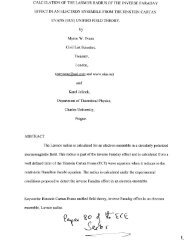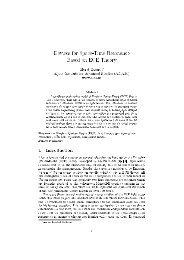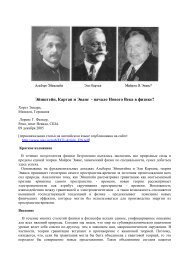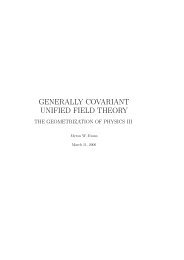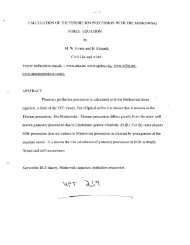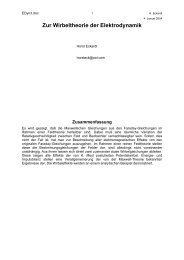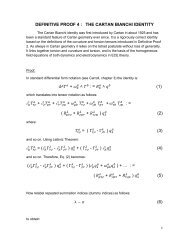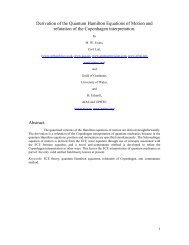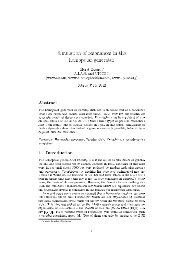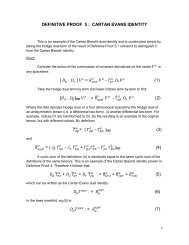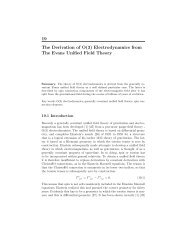Einstein, Cartan and Evans – Start of a New Age in Physics? - Aias.us
Einstein, Cartan and Evans – Start of a New Age in Physics? - Aias.us
Einstein, Cartan and Evans – Start of a New Age in Physics? - Aias.us
You also want an ePaper? Increase the reach of your titles
YUMPU automatically turns print PDFs into web optimized ePapers that Google loves.
ECE Theory, H. Eckardt, L. Felker 09. Dec. 2005<br />
Introduction<br />
For centuries, physicists <strong>and</strong> philosophers sought a unified description <strong>of</strong> all phenomena <strong>of</strong><br />
Nature. We know today that the world at the sub-microscopic quantum scale behaves very<br />
differently than our familiar macroscopic experience. In particular, theories <strong>of</strong> gravitation<br />
have been irreconcilable with quantum theory. Therefore, one expects that, if gravitation<br />
could be unified with quantum theory, wholly new <strong>in</strong>sights would result. It now appears that<br />
this unification has been achieved, but not <strong>in</strong> the manner expected by previo<strong>us</strong> generations<br />
<strong>of</strong> scientists. This unification predicts fundamental new effects <strong>–</strong> for example, the production<br />
<strong>of</strong> energy (or power) without need for <strong>in</strong>put <strong>of</strong> other primary energy. This prediction, among<br />
others, is creat<strong>in</strong>g great <strong>in</strong>terest <strong>in</strong> pr<strong>of</strong>essional <strong>and</strong> scientific circles. We now review the<br />
orig<strong>in</strong>s <strong>of</strong> this unification.<br />
Albert <strong>E<strong>in</strong>ste<strong>in</strong></strong> <strong>in</strong> 1915 published a theory <strong>of</strong> the gravitational <strong>in</strong>teraction; he called this the<br />
theory <strong>of</strong> General Relativity, <strong>and</strong> today it provides the basis for our underst<strong>and</strong><strong>in</strong>g <strong>and</strong><br />
exploration <strong>of</strong> the cosmos at large. In 1905, <strong>E<strong>in</strong>ste<strong>in</strong></strong> had already produced the theory <strong>of</strong><br />
Special Relativity, which rests upon the well-known postulate <strong>of</strong> “constancy <strong>of</strong> the speed <strong>of</strong><br />
light“ <strong>in</strong> vacuum. Dur<strong>in</strong>g the last thirty years <strong>of</strong> his life, <strong>E<strong>in</strong>ste<strong>in</strong></strong> looked for a still more<br />
comprehensive unified theory which could cover all known natural forces. He spent the years<br />
from approximately 1925 to 1955 <strong>in</strong> this search, but did not reach his desired goal. S<strong>in</strong>ce the<br />
discovery <strong>of</strong> quantum mechanics <strong>in</strong> the 1920’s, the majority <strong>of</strong> physicists b<strong>us</strong>ied themselves<br />
with this, <strong>and</strong> not with General Relativity. The fact that quantum mechanics is consistent<br />
only with Special Relativity, but not with General Relativity, was overlooked or ignored. In<br />
addition, while quantum mechanics is successful <strong>in</strong> describ<strong>in</strong>g the electron sheath <strong>of</strong> atoms;<br />
it is not a suitable theory for the high mass-densities which occur with<strong>in</strong> atomic nuclei.<br />
Other notable progress toward unified theory <strong>in</strong> the 20th century consisted <strong>of</strong> a unification <strong>of</strong><br />
electromagnetism with the weak nuclear force, via an extension <strong>of</strong> the formalism <strong>of</strong> quantummechanics.<br />
Gravitation has rema<strong>in</strong>ed, until today, outside the St<strong>and</strong>ard Model <strong>of</strong> particle<br />
physics.<br />
Elie <strong>Cartan</strong> is less well-known than <strong>E<strong>in</strong>ste<strong>in</strong></strong>. He was a French mathematician who<br />
exchanged ideas with <strong>E<strong>in</strong>ste<strong>in</strong></strong> concern<strong>in</strong>g many details <strong>of</strong> General Relativity. <strong>Cartan</strong>’s<br />
orig<strong>in</strong>al <strong>in</strong>sight was that electromagnetism could be derived, via differential geometry, from<br />
the geometry <strong>of</strong> space-time <strong>–</strong> more or less <strong>in</strong> parallel with <strong>E<strong>in</strong>ste<strong>in</strong></strong>’s <strong>in</strong>sight that gravitation<br />
could be derived from space-time geometry.<br />
A successful unification, however, was not achieved by <strong>Cartan</strong> <strong>and</strong>/or <strong>E<strong>in</strong>ste<strong>in</strong></strong>. The<br />
unification was f<strong>in</strong>ally achieved <strong>in</strong> the year 2003 by Myron <strong>Evans</strong> who, tra<strong>in</strong>ed as a chemical<br />
physicist, brought fresh <strong>in</strong>sight to the problem. <strong>Evans</strong> held several academic pr<strong>of</strong>essorships<br />
<strong>in</strong> Engl<strong>and</strong> <strong>and</strong> the USA, before he was forced to withdraw beca<strong>us</strong>e <strong>of</strong> his unorthodox views,<br />
<strong>and</strong> he now works as a “private researcher“ <strong>in</strong> his homel<strong>and</strong> <strong>of</strong> Wales. From there, he<br />
conducts the “Alpha Institute for Advanced Study“ (AIAS), which presents his ideas to the<br />
public as a world-wide team or work<strong>in</strong>g-group. A popular-scientific presentation is <strong>in</strong> [3].<br />
Recently concentrat<strong>in</strong>g its work on energy production from the vacuum -- a topic which<br />
established science avoids <strong>–</strong> the AIAS website generates large <strong>in</strong>terest, as shown by the<br />
steady <strong>in</strong>crease <strong>in</strong> web-page statistics on the AIAS site [4]. Many well-known universities <strong>and</strong><br />
research establishments world-wide have visited these pages.<br />
1 The four natural forces<br />
To underst<strong>and</strong> the importance <strong>of</strong> unification, one m<strong>us</strong>t start with knowledge <strong>of</strong> the quantities<br />
be<strong>in</strong>g unified. It is widely accepted <strong>in</strong> physics that all <strong>in</strong>teractions <strong>in</strong> Nature are<br />
manifestations <strong>of</strong> four fundamental forces. . We characterize these briefly as follows:<br />
1. The seem<strong>in</strong>gly separate force-fields generated by electrostatic charge <strong>and</strong><br />
magnetism were united <strong>in</strong> the 19th century, largely by Maxwell, <strong>in</strong>to what is now<br />
called electromagnetism, or the electromagnetic field.


